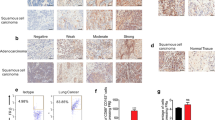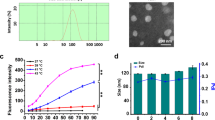Abstract
Many studies have reported a close association between VEGF and tumor angiogenesis. The aim of the present study was to evaluate the effectiveness of gene therapy against cancer, including peritoneal metastasis, using a cDNA encoding a soluble type of Flt-1, one of the VEGF receptors. In a peritoneal metastasis model of MKN45 human gastric cancer cells, mice repetitively treated with intraperitoneal injections of HVJ-Fex, a type of HVJ-cationic liposome encapsulating a plasmid expressing soluble mFlt-1, exhibited smaller disseminated foci with fewer microvessels, thus resulting in a significantly longer survival period than the control mice. In another peritoneal metastasis model using HT1080S cells, a clone of HT1080 human fibrosarcoma cells stably transfected with hVEGF, treatments with HVJ-Fex also reduced the growth of disseminated foci without ascites formation. In conclusion, this study demonstrated that the peritoneal metastases of some cancers were largely dependent on VEGF, and that the repeated intraperitoneal transduction of a soluble flt-1 gene using HVJ-cationic liposomes suppressed peritoneal metastases, thereby contributing to a longer survival period.
This is a preview of subscription content, access via your institution
Access options
Subscribe to this journal
Receive 12 print issues and online access
$259.00 per year
only $21.58 per issue
Buy this article
- Purchase on Springer Link
- Instant access to full article PDF
Prices may be subject to local taxes which are calculated during checkout




Similar content being viewed by others
References
Folkman J . Tumor angiogenesis Adv Cancer Res 1985 43: 175–203
Ferrara N, Henzel WJ . Pituitary follicular cells secrete a novel heparin-binding growth factor specific for endothelial cells Biochem Biophys Res Commun 1989 161: 851–858
Brown LF et al. Expression of vascular permeability factor (vascular endothelial growth factor) and its adenocarcinomas of the gastrointestinal tract Cancer Res 1993 53: 4727–4735
Plate KH et al. Upregulation of vascular endothelial growth factor and its cognate receptors in a rat glioma model of tumor angiogenesis Cancer Res 1993 53: 5822–5827
Suzuki K et al. Expression of vascular permeability factor/vascular endothelial growth factor in human hepatocellular carcinoma Cancer Res 1996 56: 3004–3009
Kim KJ et al. Inhibition of vascular endothelial growth factor-induced angiogenesis suppresses tumour growth in vivo Nature 1993 362: 841–844
Millauer B et al. Glioblastoma growth inhibited in vivo by a dominant-negative Flk-1 mutant Nature 1994 367: 576–579
Takahashi Y et al. Expression of vascular endothelial growth factor and its receptor, KDR, correlates with vascularity, metastasis, and proliferation of human colon cancer Cancer Res 1995 55: 3694–3968
Warren RS et al. Regulation by vascular endothelial growth factor of human colon cancer tumorigenesis in a mouse model of experimental liver metastasis J Clin Invest 1995 95: 1789–1797
Asano M et al. Inhibition of tumor growth and metastasis by an immunoneutralizing monoclonal antibody to human vascular endothelial growth factor/vascular permeability factor121 Cancer Res 1995 55: 5296–5301
Mise M et al. Clinical significance of vascular endothelial growth factor and basic fibroblast growth factor gene expression in liver Hepatology 1996 23: 455–464
Cheng SY et al. Suppression of glioblastoma angiogenicity and tumorigenicity by inhibition of endogenous expression of vascular endothelial growth factor Proc Natl Acad Sci USA 1996 93: 8502–8507
Saleh M, Stacker SA, Wilks AF . Inhibition of growth of C6 glioma cells in vivo by antisense vascular endothelial growth factor sequence Cancer Res 1996 56: 393–401
Mori A et al. VEGF-induced tumor angiogenesis and tumorigenicity in relation to metastasis in a HT1080 fibrosarcoma cell line Int J Cancer 1999 80: 738–743
Shibuya M et al. Nucleotide sequence and expression of a novel human receptor-type tyrosine kinase gene (flt) closely related to fms family Oncogene 1990 5: 519–524
Terman BI et al. Identification of the KDR tyrosine kinase as a receptor for vascular endothelial growth factor Biochem Biophys Res Commun 1992 187: 1579–1586
de Vries C et al. The fms-like tyrosine kinase, a receptor for vascular endothelial growth factor Science 1992 255: 989–991
Millauer B et al. A high affinity VEGF binding and development expression suggest FLK-1 as a major regulator of vasculogenesis and angiogenesis Cell 1993 72: 835–846
Finnerty H et al. Molecular cloning of murine FLT and FLT4 Oncogene 1993 8: 2293–2298
Kendall RL, Thomas KA . Inhibition of vascular endothelial cell growth factor activity by an endogenously encoded soluble receptor Proc Natl Acad Sci USA 1993 90: 10705–10709
Roeckl W et al. Differential binding characteristics and cellular inhibition by soluble VEGF receptors 1 and 2 Exp Cell Res 1998 241: 161–170
Hiratsuka S et al. Flt-1 lacking the tyrosine kinase domain is sufficient for normal development and angiogenesis in mice Proc Natl Acad Sci USA 1998 95: 9349–9354
Lin P et al. Inhibition of tumor growth by targeting endothelium using a soluble vascular endothelial growth factor receptor Cell Growth Differ 1998 9: 49–58
Goldman CK et al. Paracrine expression of native soluble vascular endothelial growth factor receptor inhibits tumor growth, metastasis and mortality rate Proc Natl Acad Sci USA 1998 95: 8795–8800
Kong HL et al. Regional suppression of tumor growth by in vivo transfer of a cDNA encoding a secreted form of the extracellular domain of flt-1 vascular endothelial growth factor receptor Hum Gene Ther 1998 9: 823–833
Aoki K et al. Gene therapy for peritoneal dissemination of pancreatic cancer by liposome-mediated transfer of herpes simplex virus thymidine kinase gene Hum Gene Ther 1997 8: 1105–1113
Nakanishi M et al. Efficient introduction of contents of liposomes into cells using HVJ (Sendai virus) Exp Cell Res 1985 159: 399–409
Kaneda Y et al. The improved efficient method for introducing macromolecules into cells using HVJ (Sendai virus) liposomes with gangliosides Exp Cell Res 1987 173: 56–69
Saeki Y et al. Development and characterization of cationic liposomes conjugated with HVJ (Sendai virus): reciprocal effect of cationic lipid for in vitro and in vivo gene transfer Hum Gene Ther 1997 8: 2133–2141
Senger DR et al. Tumor cells secrete a vascular permeability factor that promotes accumulation of ascites fluid Science 1983 219: 983–985
Morishita R et al. Single intraluminal delivery of antisense cdc2 kinase and proliferating-nuclear antigen oligonucleotides results in chronic inhibition of neointimal hyperplasia Proc Natl Acad Sci USA 1993 90: 8474–8478
Sawa Y et al. Efficiency of in vivo gene transfection into transplanted rat heart by coronary infusion of HVJ liposome Circulation 1995 92: 479–482
Hirano T et al. Persistent gene expression in rat liver in vivo by repetitive transfections using HVJ-liposome Gene Therapy 1998 5: 459–464
Ueki T et al. Hepatocyte growth factor gene therapy of liver cirrhosis in rat Nature Med 1999 5: 226–230
Boehm T, Folkman J, Browder T, O'Reilly MS . Antiangiogenic therapy of experimental cancer does not induce acquired drug resistance Nature 1997 390: 404–407
Folkman J . Antiangiogenic gene therapy Proc Natl Acad Sci USA 1998 95: 9064–9066
Kaneda Y, Iwai K, Uchida T . Increased expression of DNA cointroduced with nuclear protein in adult rat liver Science 1989 243: 375–378
Wilke M et al. Efficacy of a peptide-based gene delivery system depends on mitotic activity Gene Therapy 1996 3: 1133–1142
Mabuchi E et al. Gene delivery by HVJ-liposome in the experimental gene therapy of murine glioma Gene Therapy 1997 4: 768–772
Kikuchi A et al. Development of novel cationic liposomes for efficient gene transfer into peritoneal disseminated tumor Hum Gene Ther 1999 10: 947–955
Hirashima M et al. Maturation of embryonic stem cells into endothelial cells in an in vitro model of vasculogenesis Blood 1999 93: 1253–1263
Maddon PJ et al. The isolation and nucleotide sequence of a cDNA encoding the T cell surface protein T4: a new member of the immunoglobulin gene family Cell 1985 42: 93–104
Gao X, Huang L . A novel cationic liposomes reagent for efficient transfection of mammalian cells Biochem Biophys Res Commun 1991 179: 280–285
Acknowledgements
We thank Dr G Breier from the Max Planck Institute for Physiological and Clinical Research for providing us with the plasmid containing the full length murine flt-1 cDNA.
Author information
Authors and Affiliations
Rights and permissions
About this article
Cite this article
Mori, A., Arii, S., Furutani, M. et al. Soluble Flt-1 gene therapy for peritoneal metastases using HVJ-cationic liposomes. Gene Ther 7, 1027–1033 (2000). https://doi.org/10.1038/sj.gt.3301202
Received:
Accepted:
Published:
Issue Date:
DOI: https://doi.org/10.1038/sj.gt.3301202
Keywords
This article is cited by
-
Hypoxia-autophagy axis induces VEGFA by peritoneal mesothelial cells to promote gastric cancer peritoneal metastasis through an integrin α5-fibronectin pathway
Journal of Experimental & Clinical Cancer Research (2020)
-
A 3E8.scFv.Cys-IR800 Conjugate Targeting TAG-72 in an Orthotopic Colorectal Cancer Model
Molecular Imaging and Biology (2018)
-
Suppressive effect of bevacizumab on peritoneal dissemination from gastric cancer in a peritoneal metastasis model
Surgery Today (2010)
-
Anti-angiogenesis therapy based on the bone marrow-derived stromal cells genetically engineered to express sFlt-1 in mouse tumor model
BMC Cancer (2008)
-
Targeted polymeric gene delivery for anti-angiogenic tumor therapy
Macromolecular Research (2007)



